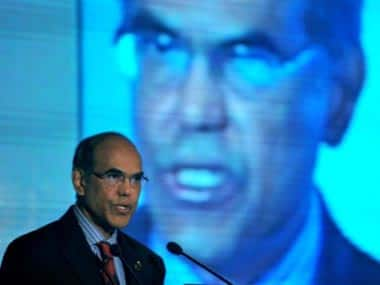As expected by most, Reserve Bank of India Governor Duvvuri Subbarao has taken a gradual approach to easing the monetary policy cycle. He has opted to adopt an indirect approach to boosting investment, rather than cut policy rates directly.
By reducing the cash reserve ratio - the portion of deposits banks must park with the central bank - by 50 basis points and releasing Rs 32,000 crore into the system, the RBI has sent a clear signal that while it is concerned about the structural constraints on liquidity, it still does not see inflation within its comfort zone, and hence does not think it necessary to cut the repo rate now.
Indeed, Subbarao says so in as many words in his policy statement: “In reducing the CRR, the Reserve Bank has attempted to address the structural pressures on liquidity in a way that is not inconsistent with the prevailing monetary stance. In the two previous guidances, it was indicated that the cycle of rate increases had peaked and further actions were likely to reverse the cycle. Based on the current inflation trajectory, including consideration of suppressed inflation, it is premature to begin reducing the policy rate. The reduction in the policy rate will be conditioned by signs of sustainable moderation in inflation.__”
Enough indication from the man himself that inflation is still a concern, but RBI is mindful of the concerns that liquidity flow to productive sectors must be easier. Given the pressures Subbarao was under, perhaps this was the best he could do under the circumstances, despite the clamour for a reduction of the repo rate from industry and the corporate sector.
[caption id=“attachment_192311” align=“alignleft” width=“380” caption=“By reducing the cash reserve ratio by 50 basis points and releasing Rs 32,000 crore into the system, the RBI signals that it is concerned about the structural constraints on liquidity and inflation.AFP”]
 [/caption]
[/caption]
In fact, Subbaro’s policy statement not so subtly seeks to tell the corporate sector that they would do well to wave their flags of protest in New Delhi rather than in Mumbai.
The RBI’s action on CRR makes it clear that the central bank does consider it to be a monetary policy tool. The fact that the central bank is seeking to send a signal on future action through the CRR cut is, again, explained directly by the governor. “The reduction can also be viewed as a reinforcement of the guidance that future rate actions will be towards lowering them.__”
But despite Subbarao’s parleys with the finance ministry before the policy announcement, the governor, to his credit, has not minced his words when it comes to fiscal profligacy. The RBI has made it clear that the real ‘significant threat’ to inflation management and – to use the RBI’s own words - macroeconomic stability, is the lack of fiscal consolidation.
In other words, a central bank can only do so much. The real problem lies with a government which refuses to tighten its belt and curb spending. The anticipated fiscal slippage caused by high levels of consumption spending by the government is what the RBI sees as the real problem. And that is as clear a warning by a central bank to a government as any. If anything, rate cut or not, Duvvuri Subbarao needs to be lauded for calling a spade a spade.
That RBI will continue to seek what can clearly be called an ‘impossible trinity’ of three ’expected outcomes’ - easing liquidity conditions, mitigating downside risks to growth and continuing to anchor medium-term inflation expectations on the basis of a credible commitment to low and stable inflation.
That the real solution lies with the man he met last week - Finance Minister Pranab Mukherjee - has been emphasised by Subbarao. The policy statement underscores the imperative of fiscal consolidation, “which will shift the balance of aggregate demand from public to private and from consumption to capital formation”. These, he says, are critical to create the space for lowering the policy rate without the imminent risk of resurgent inflation.
“In the absence of credible fiscal consolidation, the Reserve Bank will be constrained from lowering the policy rate in response to decelerating private consumption and investment spending. The forthcoming Union Budget must exploit the opportunity to begin this process in a credible and sustainable way.__”
Strong words from the governor of a central bank caught in a cleft-stick. But the point is, will a government paralysed by a million problems have the courage to listen?
Sourav Majumdar has been a financial journalist for over 18 years. He has worked with leading business newspapers and covered the corporate sector and financial markets. He is based in Mumbai.
)